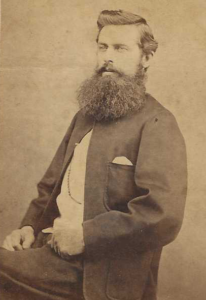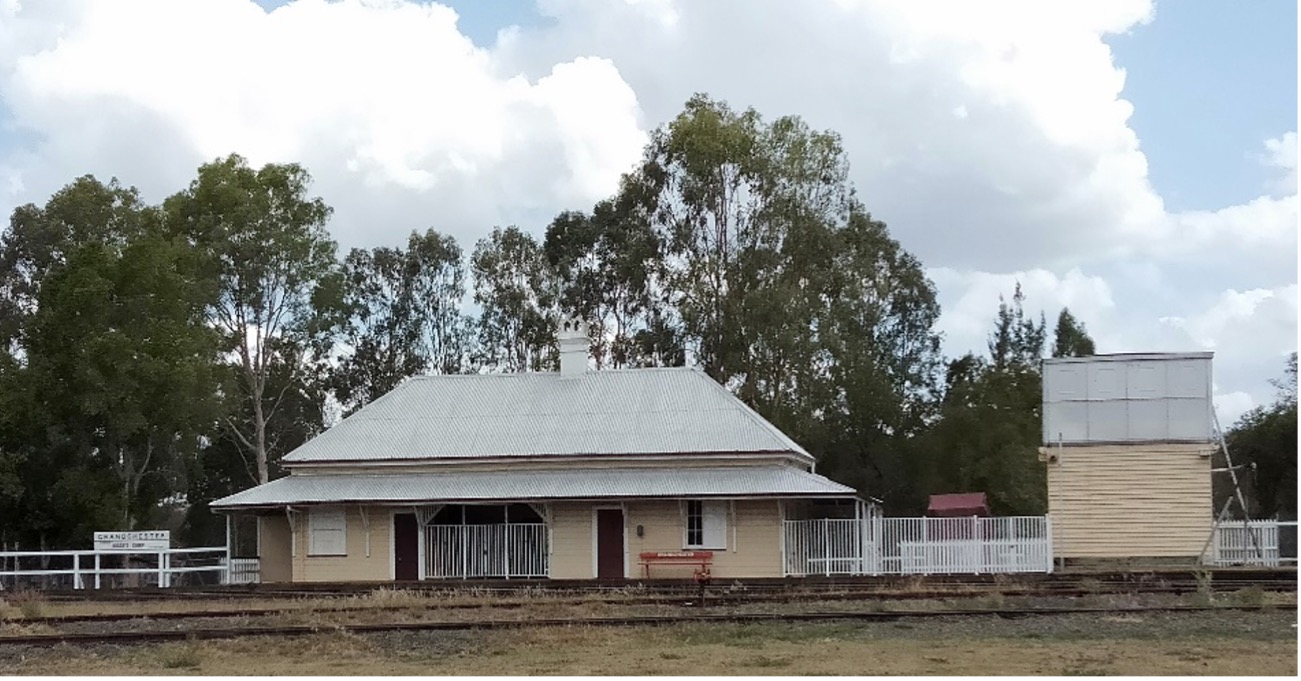A letter home: Tracing my Thompson family.

William, Eleanor and Margaret (at back) and Richard (Catherine’s grandfather, seated at front). Author’s family collection.
In 2013, I joined the family history website Ancestry.com and started my genealogy journey on the internet, adding names, scanning documents and photos, into my family tree.
It was while working through this process that an American family tree showed as a hint. Out of curiosity I went into the tree to investigate. The names recorded did not match my records but to my surprise the tree included a photo that I had in my possession. It was a portrait of the youngest children of my Great grandparents, James Joseph Thompson and Eleanor Mary Hamilton, Brisbane, Queensland, who married at St. Mary’s RC Church Ipswich in 1868.[1]
It was an amazing moment. How did that photo come into the hands of this American family? A message was forwarded to the owner of the tree and early next morning there was a reply from a descendant of Eliza Thompson-Hogan. The date was 14 February 2014.
In Boston, Massachusetts, stored in a basement of the family home was an old trunk. Eliza’s eldest child, Katherine McMahon, had become the guardian of the trunk but it wasn’t until the death of a great aunt, that access was gained to examine its contents.
Among the contents was a letter written by my Great grandfather, dated 17 July 1865 from Queensland, Australia.
Eliza was James’ oldest sister, a half-sibling, who had sailed to America with her younger sister, Bridget, arriving in New York,1852.[2] From the letter, however, we discover that Eliza had returned to Ireland and had been living in Newbridge, Co Kildare where she had married James Hogan in 1859.[3] In Feb 1860 they had a son, Daniel Hogan born in Newbridge, County Kildare.[4]
While James and Thomas were living in Ipswich and employed with the Railway Dept from about April 1865, their possible arrival date in Australia would have been around late 1864-early 1865.

James writes ‘I have got a government appointment on the railway this last three months, and I got Thomas in along with me’ and believed that ‘a steady man can make a bit of money by good look and hard work.’ He continued ‘Masons carpenters and other tradesmen get from 10 shillings to 11 (per day) when at work but it is not every day they get work.’ He describes the life of the men in Australia who couldn’t find work or do not have an allotment of their own, as ‘bushmen’ who ‘are generally able to take their house and furniture on their back and swag it to some other township’.[5] These men ‘think nothing of walking 12 or 14 hundred miles ‘with ‘1 pair of pants 1 pair of boots 1 shirt and 1 hat’. At night he makes ‘his house of some sheets of bark which he knocks off a gum tree with his tomahawk and his bed and bedding 2 empty sacks if he can manage to get them, which he makes into a bunk by means of 4 fork sticks and 2 long sticks which he turns through his sack and then he gets into his bunk and roles his blanket about him’. ‘He travels all day till night comes on, puts down his swag takes out his matches sets fire to an old tree boils his billy, make his damper, which means a cake and has his supper and rolls himself in his blanket and lies at the fire until morning when he gets up, has his breakfast and precedes on his journey. Such is life in Australia’

Portrait of James J Thompson c1868, Ipswich, Qld. Author’s private collection.
While sounding optimistic he was missing home and writes about the neighbour, ‘I did not trouble myself about them when at home, yet I would like to know how they are doing…You can remember us to all our kind friends and neighbours…. Write soon and send us a lot of news’. ‘James & Thomas Thompson’.
With this discovery, it wasn’t long before I was on a plane to visit Eliza’s descendants where I enjoyed three wonderful weeks of great American hospitality. It is thanks to Eliza and her family that so much more is known about the Thompson family from Co Kildare, Ireland. Before leaving, I was given two more letters written by both my Great grandparents, James and Eleanor Thompson.
The last letter written by James to his sister, Eliza was dated January 1900. At the time he had been very sick and had been attended to daily for two months by the Doctor and the Parish Priest, although he returned to work after this illness. Eliza Hogan died in Boston, Massachusetts in 1904.[6] James died in his home at Red Hill on the 12 March 1912.[7] His wife, Eleanor (known as Nell) died the following year at the age of 68.[8]
According to official Queensland Railway records James Thompson was employed with the Railway Department from the First May 1878 and resigned age 69 in 1912.[9] At the time of his retirement he held the position of First-Class Guard stationed at Central Region, Roma Street, and had been granted six months extended leave, taking his retirement date up to June 1912, the date engraved on the Silver Coffee Pot.[10]

Official opening of the first section of the Ipswich to Grandchester railway, Ipswich, 31 July 1865. (n.d.). State Library of Queensland collection.
Unfortunately, not all railway records have survived. The letter to Eliza dated 17 July 1865 was written two weeks before the opening of the railway line between Ipswich and Bigge’s Camp now known as Grandchester on 31 July 1865, Queensland’s first railway line.[11]
In 2019 I visited St Brigit’s RC Church at Red Hill, Brisbane where I spotted a display cabinet at the back of the church containing some memorabilia. In it was a letter by E.J. Sharkey, ‘Memories of an Old Parishioner’. It confirmed that James Thompson of Wellington St, Red Hill, was a guard on railway that ran from Ipswich to Bigge’s Camp (now Grandchester). Sharkey’s father was a ‘navvy’ on the railway construction.
While I was in America another letter came to light. It had not been shared on Ancestry. The letter was written in 1855 by our 2nd great grandfather, Thomas Thompson, but that will be a story for another time.

Grandchester Railway station in Queensland. Image by Author in 2019.
[1] Marriage of James Thompson. Spouse Eleanor Mary Hamilton. 22/01/1868 Queensland Historical Records 1868/C/188
[2] New York, Passenger Lists, 1820-1957. Ancestry.com Operations, Inc. 2010 Provo, UT, USA
[3] Church Marriage Record. Eliza Thomson and James Hogan, 07 March 1859, RC, Newbridge, Co Kildare, www.rootsireland.ie
[4] Baptismal Record. Daniel Hogan, 27 Feb 1860, Newbridge, Co Kildare. Witnesses, Thomas and Margaret Thompson. Rootsireland.ie
[5] Swagman. Swagman – Wikipedia
[6] Death Eliza A Hogan 23 Jan 1904. Massachusetts, Death Records, 1841-1915, Ancestry.com, Ancestry.com Operations, Inc 2013
[7] Queensland Death Certificate. No 64397
[8] Queensland Death Certificate. No 21372
[9] Supplement to the Queensland Government Gazette, Railway Department, 1889-1902 and Queensland Government Gazette, Railway Department, 1903-1911. Information sent to me and copyright signed 22 Feb 1999
[10] Photo of Coffee Pot. My photo collection
[11] Railways in Queensland – History in Pictures | State Library of Queensland (slq.qld.gov.au)

Lovely story. How wonderful that you were find that letter and visit and learn from your American cousins.
Jill, I’m honored to receive a comment from you about my blog. I stayed in the States for 3 weeks with the family. Everyone wanted to meet me. I can only praise them, but it has certainly expanded my world view of family. I could have written much more about the family as I looked more closely at the history of the railway and the Thompson family.
It’s obvious that you treasure your family history Catherine. I enjoyed reading your story.
Bev, thankyou. It’s encouraging to receive a comment about the blog. My family say I talk too much about family history, but I realize now that although I haven’t covered everything I would have liked to have written, its enough to share with my family and give them a little synopsis of an ancestor and my genealogical journey of discovery.
Thats great writing Aunty Catherine.
Thankyou so much. I’m glad you enjoyed reading it. Aunty